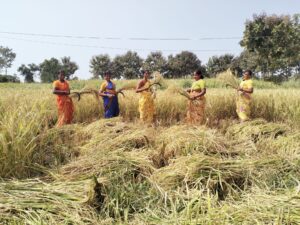Increasing the yield potential of rice has always been the priority in working to increase food security. But, in the race to feed the world, grain quality, is sometimes forgotten. Developing rice varieties without considering grain quality can leave farmers with a low-value product and consumers with rice they find unappealing to eat. So, IRRI is developing strategies to improve grain quality in rice with high yield potential.
Grain quality is not a luxury
Grain quality traits such as size, fragrance, shape, texture, color, and taste may be perceived as something of interest to only richer consumers. In fact, rice consumers across the globe look at the same indicators to define their own preferences. Since more than half of the world’s population eats rice, many of whom are poor, the preferences of the poorest rice consumers matter to ensure that their rice is both nutritious and palatable.
Likewise, farmers see the value of grain quality because better quality means higher prices, and this can translate into more profit. However, some farmers continue to plant low-yielding varieties—because the grain quality of higher-yielding varieties is unacceptable to local consumers. So, ensuring good or even better grain quality is one way of encouraging farmers to adopt more productive rice varieties.
Grain quality is also an important factor during the milling process. It determines whether the grains can withstand milling without breaking. Broken grains have a lower value and can reduce the quantity of grain that reaches the consumers.
Uncompromised quality
“In the past, increasing yield somehow compromised grain quality. But unimpaired grain quality and optimum yield are something that we would like to have at the end of the day,” explains Nese Sreenivasulu, head of the Grain Quality and Nutrition Center (GQNC) at the International Rice Research Institute (IRRI). “Since 2004, the GQNC team has been analyzing various grain quality traits in different types of rice to help breeders select and develop varieties with enhanced grain quality.
“Grain composition matters to the whole community because of its commercial importance. That’s why we are improving grain quality by also increasing the grain’s nutritional value,” says Dr. Sreenivasulu.
The GQNC team evaluates physical traits (chalkiness, head rice yield, milling potential, and grain dimensions) and several biochemical traits (amylose content, gelatinization temperature, gel consistency, viscosity, grain elongation, and aroma). These traits help assess milling potential and grain composition, the two major aspects of overall grain quality.
Size and shape
Dr. Sreenivasulu explains that rice has a rich diversity in grain size and shape, and consumer preferences for these traits vary among different regions. For instance, in India, people in the northwest area prefer long grains while those in the east like short grains.
“With the recent success in identifying various genes for grain size, we are in a better position to breed new rice varieties with short or long grains to suit distinct regional preferences,” Dr. Sreenivasulu says.
Chalkiness
Grain appearance is judged by its opacity or chalkiness—or to the nonexperts—how translucent or how white it is. Consumers generally prefer rice with a translucent grain. Hence, chalky rice is less acceptable in the market.
Chalkiness is also undesirable because it makes rice grains weak and prone to breaking when milled. Rice with broken grains fetches a much lower price in the market. So, from a marketing perspective, high quality often means more whole grains after milling.
In 2012, in an IRRI study supported by the Australian Centre for International Agricultural Research, Melissa Fitzgerald, then head of GQNC, and her team identified important genetic information on what makes rice chalky. With this discovery, IRRI scientists are optimistic about developing higher quality chalk-free rice varieties in the future.
Aroma
Aroma is an important trait that is generally associated with high-quality grains such as those of jasmine and basmati rice. IRRI and other research institutions have shown that most aromatic rice shares the same version of the aroma gene, badh2. Farmers have highly prized rice with this gene for thousands of years. Different rice varieties with this gene were widely adopted throughout the ancient rice-growing world.
However, what makes rice grains aromatic remains a scientific mystery today. Although 2-acetyl-1- pyrroline (2AP), the main aromatic compound responsible for the fragrance of jasmine and basmati rice varieties, has been identified, more than 150 different unknown aromatic compounds exist, says Dr. Sreenivasulu. Researchers are yet to fully understand the significance of those compounds in contributing to the aroma.
Taste
Dr. Fitzgerald and other collaborating scientists conducted research to differentiate “premium” rice from “second best” varieties from Thailand, China, the Philippines, Japan, Australia, Pakistan, India, Iran, and Brazil. Through descriptive sensory analyses with a group of trained panelists, they found that sweet taste played a major role in distinguishing the premium rice varieties among consumers in Southeast Asia.
Texture
The economic value of rice also depends on its cooking and eating qualities. In South Asia, particularly in India and Pakistan, aromatic basmati rice is highly preferred for its dry texture as the grains never stick to each other. In Southeast Asian countries such as Thailand and Lao PDR, aromatic and slightly sticky jasmine rice is highly desired.
Amylose content and gel consistency strongly influence the cooking and eating characteristics of rice. Dr. Sreenivasulu explains that rice with high amylose content is harder and nonsticky when cooked. These are the kinds that are most suited for people with type 2 diabetes. When cooked rice cools, rice with high amylose content can be either firm or soft as indicated by its gel consistency. Hard gel consistency often means the cooked rice is firmer.
“We are also interested in exploring grains with high protein content and combining this trait with high amylose in rice to reduce its glycemic index,” Dr. Sreenivasulu says. “By manipulating amylose content among other factors, we can influence grain quality to make rice healthier.”
Sensory evaluation
Understanding rice’s composition and desirable traits is only the first step to improving grain quality. The next step, perhaps the most important one, is to have the value of these traits validated by consumers.
This is where Rosa Paula Cuevas, a postdoctoral fellow at GQNC, comes in. She conducts a regular sensory evaluation of rice with a group of panelists to better describe and understand the “mouthfeel” and other quality attributes of rice. She hopes that sensory evaluation can bridge what people experience when they eat rice with what scientists understand about grain components.
“Although amylose content and gel consistency can measure hardness, these do not give a complete picture of what consumers perceive,” Dr. Cuevas says. “That’s when sensory evaluation can be used to explore what current routine tests are missing out on. It helps ensure that rice breeding programs reflect the qualities that consumers want.”
Seeds for the future
According to Dr. Sreenivasulu, environmental conditions such as drought, salinity, flooding, and high temperature adversely affect grain quality.
”Our goal at GQNC is to attain high grain quality while maintaining high yield in the face of unfavorable environments,” he says. “As of now, we do not fully understand how climate change alters the grain filling process at the molecular level. Therefore, our priority should remain with developing varieties with the best grain quality suited for the changing climate.
“Our strategy is to explore the vast genetic diversity of rice in the International Rice Genebank, harness what is already known about quality traits across different environments, and uncover potential genes conferring enhanced grain quality under abiotic stresses,” he says. “This will help rice breeders select traits that are of interest for consumers and incorporate those traits into new rice varieties.”
For Dr. Sreenivasulu and his team, the work has a long way to go. “IRRI further needs to complement the outcome of this holistic knowledge to optimize precision breeding in order to develop the best quality rice that is suited for changing environments,” he concludes.
Ms. Ebron is a public relations officer at IRRI.









